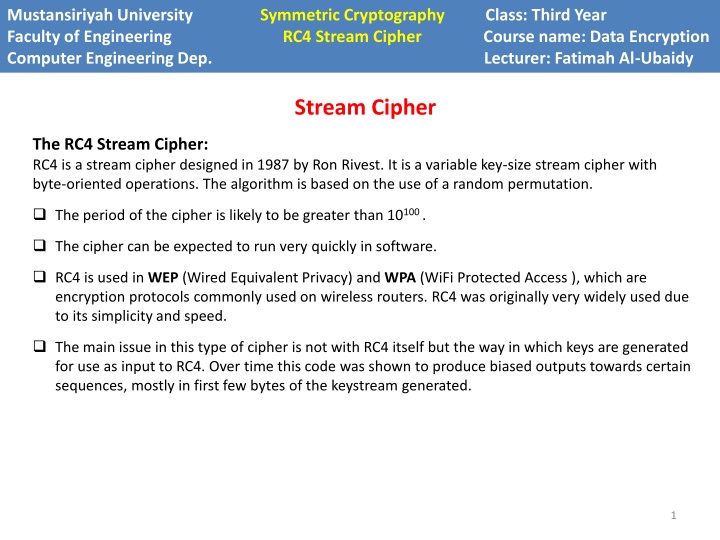
RC4 Stream Cipher: Overview and Implementation at Mustansiriyah University
Explore the RC4 stream cipher, designed in 1987 by Ron Rivest, used in encryption protocols like WEP and WPA. Learn about the key initialization, permutation, and stream generation steps involved in RC4. Join the Data Encryption course at Mustansiriyah University to dive deeper into computer security protocols.
Download Presentation

Please find below an Image/Link to download the presentation.
The content on the website is provided AS IS for your information and personal use only. It may not be sold, licensed, or shared on other websites without obtaining consent from the author. If you encounter any issues during the download, it is possible that the publisher has removed the file from their server.
You are allowed to download the files provided on this website for personal or commercial use, subject to the condition that they are used lawfully. All files are the property of their respective owners.
The content on the website is provided AS IS for your information and personal use only. It may not be sold, licensed, or shared on other websites without obtaining consent from the author.
E N D
Presentation Transcript
Mustansiriyah University Faculty of Engineering RC4 Stream Cipher Course name: Data Encryption Computer Engineering Dep. Lecturer: Fatimah Al-Ubaidy Symmetric Cryptography Class: Third Year Stream Cipher The RC4 Stream Cipher: RC4 is a stream cipher designed in 1987 by Ron Rivest. It is a variable key-size stream cipher with byte-oriented operations. The algorithm is based on the use of a random permutation. The period of the cipher is likely to be greater than 10100 . The cipher can be expected to run very quickly in software. RC4 is used in WEP (Wired Equivalent Privacy) and WPA (WiFi Protected Access ), which are encryption protocols commonly used on wireless routers. RC4 was originally very widely used due to its simplicity and speed. The main issue in this type of cipher is not with RC4 itself but the way in which keys are generated for use as input to RC4. Over time this code was shown to produce biased outputs towards certain sequences, mostly in first few bytes of the keystream generated. 1
Mustansiriyah University Faculty of Engineering RC4 Stream Cipher Course name: Data Encryption Computer Engineering Dep. Lecturer: Fatimah Al-Ubaidy Symmetric Cryptography Class: Third Year RC4 Procedure The RC4 algorithm: A variable-length key of from 1 to 256 bytes (8 to 2048 bits) is used to initialize a 256-byte state vector S, with elements S[0], S[1],..., S[255]. For encryption and decryption, a byte Kis generated from S by selecting one of the 255 entries in a systematic fashion. As each a new generated value of K, the entries in S are once again permuted. Step 1: Initialization of S To begin, (a) the entries of S are set equal to the values from 0 through 255 in ascending order; that is; S[0] = 0, S[1] = 1,...,S[255] = 255. (b) A temporary vector, T, is also created. If the length of the key K is 256 bytes, then K is transferred to T. Otherwise, for a key of length keylenbytes, the first keylen elements of T are copied from K and then K is repeated as many times as necessary to fill out T. 2
Mustansiriyah University Faculty of Engineering RC4 Stream Cipher Course name: Data Encryption Computer Engineering Dep. Lecturer: Fatimah Al-Ubaidy Symmetric Cryptography Class: Third Year RC4 Algorithm The preliminary operations can be summarized as follows: for i = 0 to 255 do S[i] = i; T[i] = K[i mod keylen]; Step 2: Initial Permutation of S Next we use T to produce the initial permutation of S. This involves starting with S[0] and going through to S[255], and, for each S[i], swapping S[i] with another byte in S according to a scheme dictated by T[i]: j = 0; for i = 0 to 255 do j = (j + S[i] + T[i]) mod 256; Swap (S[i], S[j]); Because the only operation on S is a swap, the only effect is a permutation. S still contains all the numbers from 0 through 255. 3
Mustansiriyah University Faculty of Engineering RC4 Stream Cipher Course name: Data Encryption Computer Engineering Dep. Lecturer: Fatimah Al-Ubaidy Symmetric Cryptography Class: Third Year RC4 Algorithm Step3: Stream Generation Once the S vector is initialized, the input key is no longer used. Stream generation involves cycling through all the elements of S[i], and, for each S[i], swapping S[i] with another byte in S according to a scheme dictated by the current configuration of S. After S[255] is reached, the process continues, starting over again at S[0]: i, j = 0; while (true) i = (i + 1) mod 256; j = (j + S[i]) mod 256; Swap (S[i], S[j]); t = (S[i] + S[j]) mod 256; K = S[t]; Step 4: Encryption To encrypt, XOR the value K with the next byte of plaintext. To decrypt, XOR the value K with the next byte of ciphertext. 4















